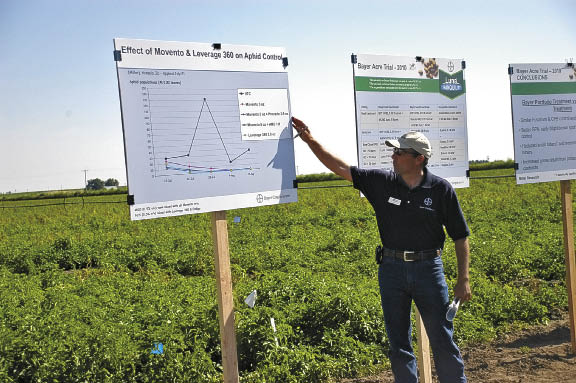 Bayer CropScience's revolutionary insecticide, Movento, which is two-way systemic, now covers even more potato sucking pests than just aphids and psyllids.
Bayer CropScience's revolutionary insecticide, Movento, which is two-way systemic, now covers even more potato sucking pests than just aphids and psyllids.
Introduced in 2008, Movento is distributed upward as well as downward in the plant to find and control even hidden pests wherever they live and feed.
"This is unlike anything we've had before in potatoes or any other crop," Kevin Adam, Bayer CropScience senior product manager, says. "Across the whole U.S., Movento is becoming the standard for the control of sucking insects and the management of tough pests such as nematodes and wireworms. That systemic movement allows us to put the product on when it is needed to manage pests. When applied to the foliage, it gets into the leaf and moves with the sugars to wherever the plant is growing."
Movento is active by ingestion against immature insect pests feeding on treated plants. Studies have shown a significant impact on exposed female adult pests by reducing fecundity and survival of offspring, providing more effective overall reduction in pest pressure.
Key potato pests Movento manages include aphids, psyllids, nematodes, wireworms and mites.
"What's new for the potato grower is, originally it was a psyllid and aphid product," Adam says. "Now it's management of all these pests."
While Movento has been on the market for four years now, indications of nematode suppression came just after the product was launched. Adam says Bayer has continued to pursue university trials in order to galvanize the effectiveness of Movento on nematodes.
"Quite honestly, [nematodes are] some of the toughest pests potatoes have," he says. "Nematodes are always a problem."
Movento has a high level of residual efficacy and protection of new plant growth, but it also has a minimal risk to natural predators when used as directed, making it an ideal addition to Integrated Pest Management (IPM) programs.
Adam points out that if you already have a wireworm or nematode problem, there's no single product on the market that will manage them.
"It's part of a management system. Growers can apply at-plant products and come back in with Movento mid-season, depending upon their potatoes that they're growing and the area that they're in, and are able to manage nematodes and wireworms later in the year."
Adam says that handling requires minimal personal protective equipment for workers, and it's very environmentally friendly-it breaks down very quickly when it comes in contact with the soil.
Dr. Saad Hafez, University of Idaho nematologist at the Parma UI R&E Center, says it's very exciting and unique because it is a new, soft chemistry, rather than the old-school chemistry that is more hazardous and toxic to the environment. Its two-way systemic movement is also an advantage.
"For the last 20 years, if I remember, we haven't seen any new development as far as nematicides until the last two to three years, which is very exciting."
Another advantage is the timing for psyllids and nematodes is the same.
"When you apply Movento to prevent the zebra chip problem, at the same time you can get nematode management."
Hafez says that growers must apply it when there is enough foliage on the plant to pick it up-it doesn't survive in the soil very long.
"You need to have some other nematicide at pre or at planting, and then you can come back with Movento, post-plant, when you have enough leaves to pick it up," he says. Those products include Telone II (Dow AgroSciences), Vapam (AMVAC) and Vydate (DuPont).
He also says growers need to add a surfactant like MSO to help penetrate leaf tissues. The label directs two applications, with a maximum of five ounces per acre per application and a total of 10 ounce maximum for the season. That's another reason, he says, growers need to have another chemical applied with it because it can only cover part of the season.
One thing growers need to be very cautious about, he says, is that Movento is not a fumigate.
Contact your local Bayer CropScience representative or pest control adviser for specific recommendations.
Visit www.movento.us.